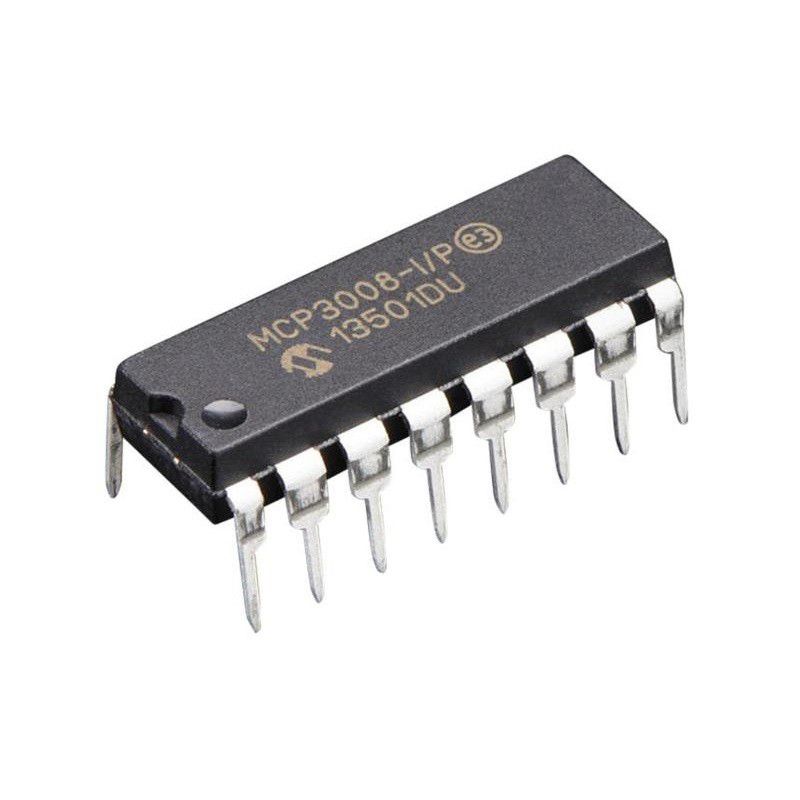

sprintf(adcreading,"ADC0 CH1= 0x%03X",adc) // read data in hexx formatįor(delay=0 delay<10000000 delay++) // delay Sprintf(adcreading,"ADC0 CH1= %u",adc) // read data in decimal format InitClocks() // Set CCLK=60Mhz and PCLK=60Mhz Return((adcdata > 6) & 0x3ff) // Return 10 bit result While(!((adcdata = AD0GDR) & 0x80000000)) // Check end of conversion (Done bit) and read result * PROJECT NAME: ADC (Analog to Digital Converter) */ When we vary resistance of POT the change in ADC count will reflect on PuTTY terminal in real time. To read ADC count from POT we will configure UART0 of LPC2148 and read data on terminal emulator (PuTTY).
#ANALOG TO DIGITAL CONVERTER MICROCONTROLLER SERIAL#
Display reading on serial emulator or display deviceĮxample Project: In this example project we will be using 10K POT to provide analog input at ADC Channel 0 i.e.Select clock for conversion & start conversion.
 Select channel we wish to use in our conversion. Configure input pin as analog input pin for ADC block. Programming Steps: ADC in LPC2148 ARM7 Microcontroller Register NameĪ/D Control Register: The ADCR register must be written to select the operating mode before A/D conversion can occurs.Ī/D Global Data Register: This register contains ADC’s DONE bit and the result of the most recent A/D conversion.Ī/D Status Register: This register contains DONE and OVERRUN flag for all the A/D Channels, as well as the A/D interrupt flag.Ī/D Global Start Register: This address can be written (in the AD0 address range) to start conversions in both A/D converters simultaneously.Ī/D Interrupt Enable Register: This register contains enable bits that allow the DONE flag of each A/D channel to be included or excluded from contributing to the generation of an A/D interrupt.Ī/D Channel x Data: ‘x’ varies from 0 to 7 The two registers we will be concerning about: ADCR (A/D Control Register) and ADGDR (A/D Global Data register). There are several registers which will be used to setup and configure ADC feature in LPC2148. Registers of ADC in LPC2148 Microcontroller Let’s have a look at table which illustrate ADC related channels and pins: ADC Related Pins in LPC2148
Select channel we wish to use in our conversion. Configure input pin as analog input pin for ADC block. Programming Steps: ADC in LPC2148 ARM7 Microcontroller Register NameĪ/D Control Register: The ADCR register must be written to select the operating mode before A/D conversion can occurs.Ī/D Global Data Register: This register contains ADC’s DONE bit and the result of the most recent A/D conversion.Ī/D Status Register: This register contains DONE and OVERRUN flag for all the A/D Channels, as well as the A/D interrupt flag.Ī/D Global Start Register: This address can be written (in the AD0 address range) to start conversions in both A/D converters simultaneously.Ī/D Interrupt Enable Register: This register contains enable bits that allow the DONE flag of each A/D channel to be included or excluded from contributing to the generation of an A/D interrupt.Ī/D Channel x Data: ‘x’ varies from 0 to 7 The two registers we will be concerning about: ADCR (A/D Control Register) and ADGDR (A/D Global Data register). There are several registers which will be used to setup and configure ADC feature in LPC2148. Registers of ADC in LPC2148 Microcontroller Let’s have a look at table which illustrate ADC related channels and pins: ADC Related Pins in LPC2148 
For more details on register description keep datasheet in hand UM10130, Chapter: 19. There are several registers associated with ADC feature but we will mainly discussing about ADC Control Register (ADCR) & ADC Global Data Register (ADGDR).
Burst conversion mode for single or multiple inputs. ADC operating frequency is 4.5 MHz (max.), operating frequency decides the conversion time. LPC2148 has two inbuilt ADC Modules, named as ADC0 & ADC1. The ADC in LPC2148 ARM7 Microcontroller is 10-bit successive approximation analog to digital converter. Introduction: ADC in LPC2148 ARM7 Microcontroller This is how step size defines an accuracy of ADC circuit. So in this case we can measure minimum 2.23 mV (Approx.) with our microcontroller. Calculate: ADC Resolution in LPC2148 ARM7 The concept of step size is closely associated with the resolution of ADC. Step size is the minimum change in input voltage which can be resolved by ADC. There is one more term important to understand while dealing with ADC and it is step size. This means our digital value or discrete level lies between 0 to 1023. So for 10-bit ADC resolution is 10-bit and maximum value will be 2 10=1024. Let’s take example: In LPC2148 microcontroller we have in-built 10-bit ADC. The resolution of ADC indicates the number of digital values. Analog To Digital Conversion What is ADC & its Resolution?Īnalog to Digital Converter (ADC) is used to convert analog signal/voltage into its equivalent digital number so that microcontroller can process that numbers and make it human readable. Let’s have a look at basics and then we will look at real world example project. Interfacing analog sensors using ADC is simple and efficient technique to read data from sensor. but ADC Analog-to-Digital converter remains famous among all. As we all know many interface methods have been developed over years to solve complex problem of balancing need of features, cost, size, power consumption, reliability etc. Microcontrollers are very useful especially when it comes to communicate with other devices, such as sensors, motors, switches, memory and even other microcontroller. Let’s learn about ADC in LPC2148 ARM7 Microcontroller.







 0 kommentar(er)
0 kommentar(er)
